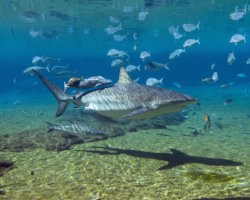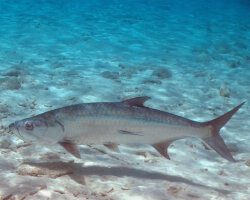Sealife guideThe white gruntHaemulon plumierii
Last updated on 09/05/2024 at 09:40 PM
Taxonomy
- Common name: White grunt, black grunt, boar grunt, flannelmouth grunt, Key West grunt, redmouth grunt, white snapper
- French name: Gorette blanche
- Spanish name: Chac-chí
- Scientific name: Haemulon plumierii (Lacepède, 1801)
- Family name: Haemulidae
- Order name: Perciformes
- Class name: Actinopterygii
Description
The white grunt is a medium-sized fish, about 12 inches long, with a maximum length of around 20 inches. It has an oblong body that is silver-white with numerous fine horizontal yellow stripes. Its pelvic, dorsal, anal, and caudal fins are all entirely yellow.

The white grunt prefers steep drop-offs or rocky overhangs
A series of blue horizontal stripes runs across the head of the white grunt, alternating with the yellow stripes.
Geographic range
The white grunt is commonly found in the Caribbean sea, the Gulf of Mexico and along the coasts of
Florida. It inhabits the tropical waters of the western Atlantic, from
Florida in the north to the coasts of Brazil in the south, including many Caribbean islands such as the Bahamas and
Guadeloupe.
Habitat
The white grunt typically lives in shallow waters, from the surface down to about 130 feet. It forms schools of varying but dense sizes around coral reefs, along rocky substrates or above sandy bottoms. The white grunt does not travel extensively with the seasons or throughout its life and generally stays in the same area.
Diet
The white grunt is a carnivorous fish that primarily feeds at night on a variety of small bottom-dwelling invertebrates like shrimp, as well as smaller fish.
Besides recreational and commercial fishing, the white grunt is often preyed upon by larger fish such as snappers, groupers and sharks.
Reproduction
The white grunt reproduces sexually. Across its range, the spawning period extends nearly throughout the year, with a peak activity lasting two months but occurring at different times depending on the geographic location.
Did you know ?
Its common english name « grunt » refers to the sounds the fish makes, which resemble the grunts of a pig. This sound is produced by the fish's well-developed teeth located in its throat.

The white grunt has a predominantly silver color with numerous fine horizontal yellow stripes
Grunts are related to snappers but are generally smaller and have more deeply forked tails.
The white grunt is listed as many other marine species within The
IUCN Red List of threatened species. The white grunt appears in the
IUCN Red List since 2016 within the category Least Concern !
Within the same genus
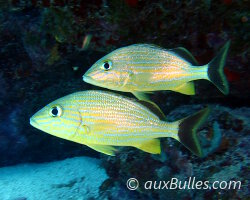
Blue striped grunt
(Haemulon sciurus)
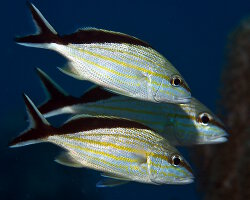
Cottonwick grunt
(Haemulon melanurum)
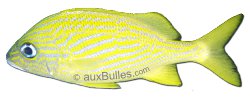
French grunt
(Haemulon flavolineatum)
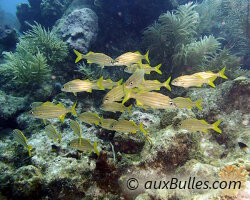
Smallmouth grunt
(Haemulon chrysargyreum)
Within the same family
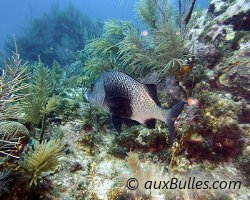
Black margate
(Anisotremus surinamensis)
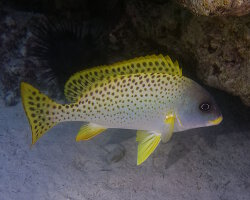
Blackspotted rubberlips
(Plectorhinchus gaterinus)

Diagonal-banded Sweetlip
(Plectorhinchus lineatus)
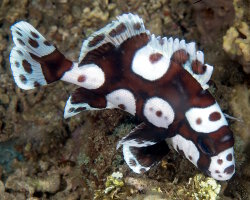
Harlequin sweetlips
(Plectorhinchus chaetodonoides)
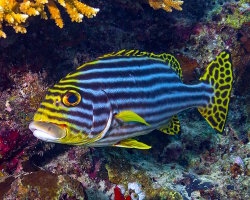
Oriental sweetlips
(Plectorhinchus vittatus)

Painted sweetlips
(Diagramma pictum)

Porkfish
(Anisotremus virginicus)
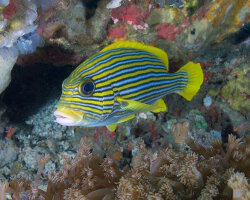
Ribboned sweetlips
(Plectorhinchus polytaenia)
Discover also

European flounder
(Platichthys flesus)

Gag grouper
(Mycteroperca microlepis)

Gold-spotted rabbitfish
(Siganus punctatus)
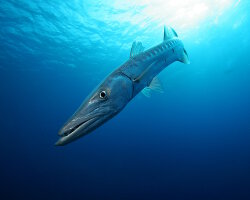
Great barracuda
(Sphyraena barracuda)

Milletseed butterflyfish
(Chaetodon miliaris)

Mutton snapper
(Lutjanus analis)
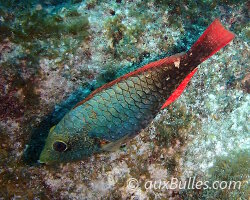
Redband parrotfish
(Sparisoma aurofrenatum)

Seaweed blenny
(Parablennius marmoreus)
The marine species from Caribbean sea
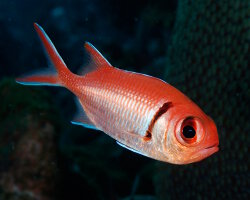
Blackbar soldierfish
(Myripristis jacobus)

Green sea turtle
(Chelonia mydas)

Labyrinthine brain coral
(Diploria labyrinthiformis)
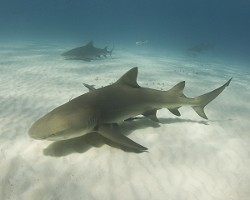
Lemon shark
(Negaprion brevirostris)
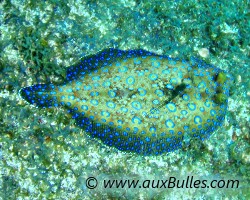
Peacock flounder
(Bothus lunatus)

Sand tilefish
(Malacanthus plumieri)

Spanish hogfish
(Bodianus rufus)
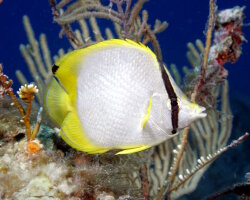
Spotfin butterflyfish
(Chaetodon ocellatus)
Dive centers

'Les Ilets' dive center

Noa dive center



































